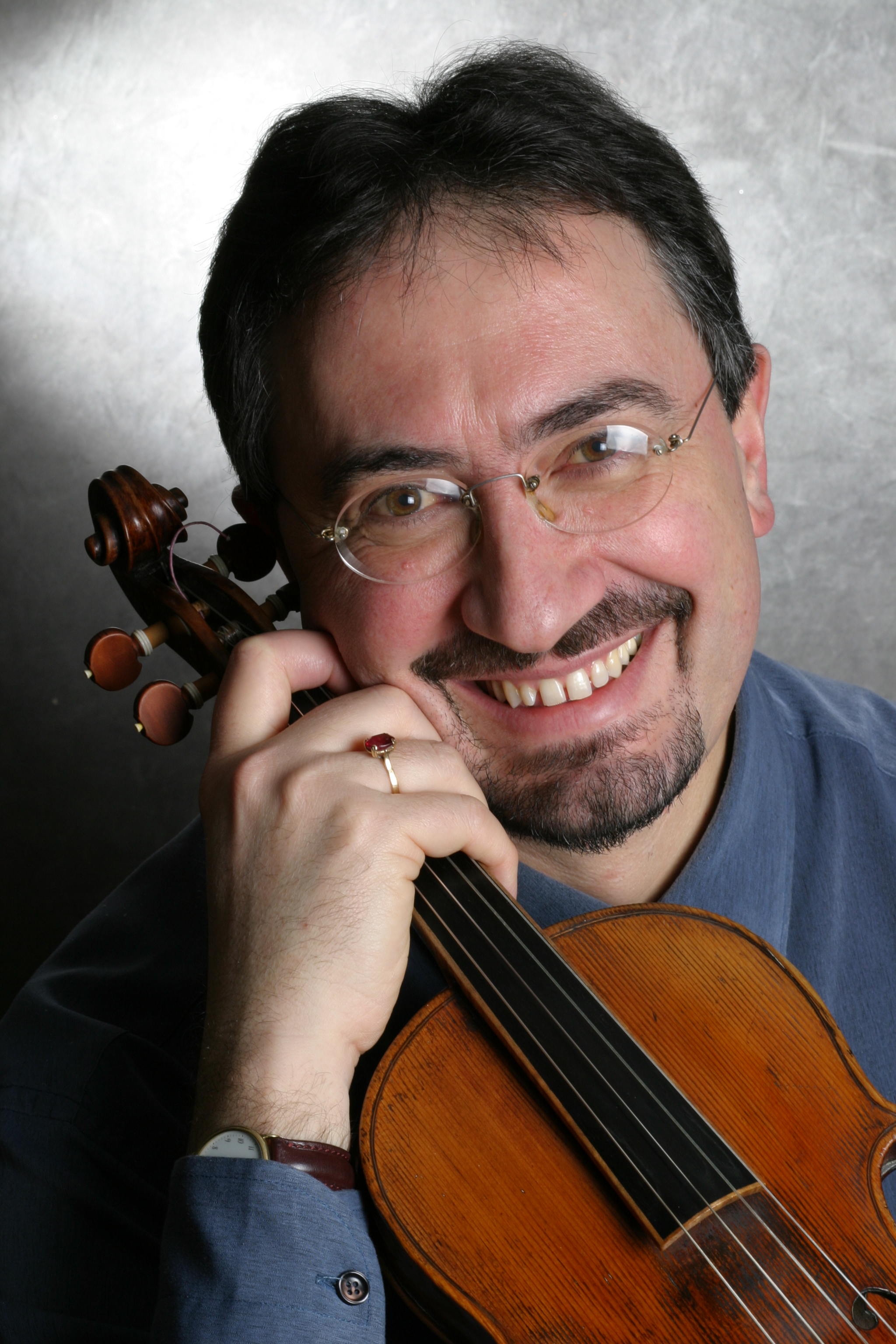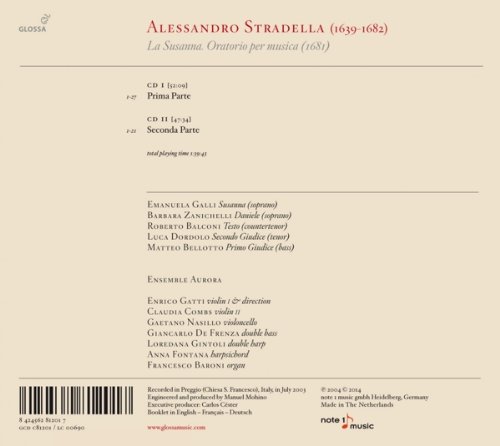Share This
Album at a Glance
Tags
Related Posts
Alessandro Stradella (1639-82): La Susanna, oratorio
Posted by Jeffrey Tarlo on Jun 27, 2014 in Baroque | 0 comments
Some composers are satisfied to live quiet but purposeful lives, have many children and leave a great musical legacy. Others are like Alessandro Stradella (1639-1682) who led the life of a scoundrel in the midst of a great musical career, living to only 42 years of age. He lived the life that movies are made of. He produced over 300 works composed for royalty, poets and clergy. He was also tried for embezzling from the church and got into many amorous affairs. He was run out of various cities, was the victim of an attempted assassination in 1677 and was murdered in 1682 by three brothers of a woman he had seduced.
Vocal music was Stradella's strength, having composed six operas and more than 170 oratorios. La Susanna is based on the same material as Handel’s oratorio composed in 1748. The narrative is taken from the biblical Book of Daniel. The first part sets up the story of a very pretty young married woman, Susanna. She is bathing nude in a private stream in her garden while two older men, both of them judges, lust after her. The men attempt to rape her but must stop when she screams out. To save themselves they lie, accusing Susanna of having an affair. If proven guilty, she would be stoned to death. In the second part of the oratorio, Susanna is imprisoned and begs the heavens for help. The young prophet Daniel arrives, saying he is an emissary of God. He speaks to both of the Judges separately and discovers that their stories differ. Daniel condemns the judges to death and frees Susanna.
Stradella scored the text written by the poet Giovanni Giardini. Musically and in form the piece sounds more like Monteverdi than Handel. There is definitely an early Baroque sound to the work. There are only five soloists: Susanna, Daniel, the two judges and a narrator. Susanna and Daniel are sopranos, one judge is a tenor, the other a bass and the narrator is a male alto (countertenor). There is a choir that at the end of the oratorio calls upon all to rejoice. Emanuela Galli sings the role of Susanna; her sound is bright and her singing makes an indelible impression. Barbara Zanichelli portrays Daniel and her singing is quite stylish and majestic. The narrator, sung by countertenor Roberto Balconi, occupies a critical role in the work. Balconi carries it off quite well, while tenor Luca Dordolo and bass Matteo Bellotto fill out the roles of the judges. Their excellent singing adds to the quality of the recording.
The Ensemble Aurora is led by Enrico Gatti with great precision and beauty. The recording was made in Preggio, Italy in July 2003 for Glossa. As with most Glossa recordings, the sonics are great and very effective.
Despite an impressive track record of Italian violin music, one that covers major figures like Corelli, Veracini and Tartini (with discs released on a variety of labels and frequently the recipients of important awards), Enrico Gatti has only recently turned to the question of recording Vivaldi, selecting the Sonatas of both the op. 1 and 2 collections with which to break a 20 year recording “silence” on the subject of the Red Priest. Gatti is the director of the Ensemble Aurora, which he founded in Italy in 1986, and has recorded the Vivaldi Trio Sonatas (playing on a 1652 Nicola Amati instrument) with this group for Glossa as well as Alessandro Stradella’s oratorio La Susanna.
Source: Glossa Music
|
Alessandro Stradella, composer |
Alessandro Stradella, composer An Italian composer of the middle baroque, Stradella enjoyed a dazzling career as a freelance composer, writing on commission, and collaborating with distinguished poets, producing over three hundred works in a variety of genres. He was an extremely influential composer at the time, though his fame was eclipsed in the next century by Corelli, Vivaldi and others. Some of his music was exploited by George Frideric Handel, for example in Israel in Egypt. Probably his greatest significance is in originating the concerto grosso. |
 Enrico Gatti, violin |
Enrico Gatti, violin, conductor Master violinist Enrico Gatti is dedicated to the study of the Baroque repertoire, and founded the Ensemble Aurora in 1986. A graduate of the Geneva Conservatory and the Royal Conservatory in The Hague, he has been professor of Baroque violin at the conservatories of Toulouse, Geneva, Basel, The Hague, Siena, and Fiesole. Gatti plays a 1789 Laurentius Storini violin from Cremona. |
|
Ensemble Aurora |
Ensemble Aurora Violinist Enrico Gatti Cellist Gaetano Nasillo teaches Baroque cello at the Palermo Conservatory and the Scuola di Musica di Fiesole. He records and plays with other European ensembles including Concerto Vocale, Ensemble 415, Le Concert des Nation, and Ars Antique Austria, among others. Nasillo plays a 1710 Barak Norman cello from London. Violinist Olivia Centurioni has also played with many of the same ensembles, and since October 2000 has been assistant professor to Enrico Gatti at the Civica Scuola de Musica in Milan. Centurioni plays a 1764 Egidius Klotz violin. Harpsichordist Guido Morini has recorded the complete works of Michelangelo Rossi and is a member of Hesperion XXI; he has performed in Italy’s most prestigious halls, including La Scala in Milan, and l’Opera di Roma. http://www.npr.org/programs/pt/4a/gatti.html
|
 Emanuela Galli, soprano |
Emanuela Galli, soprano The Italian soprano, Emanuela Galli, received her diploma in singing at the Conservatory of Music of Mântua. She has collaborated with ensembles and orchestras of Baroque music, participated in festivals and performed in the major Italian cities and abroad, and has interpreted various roles of the repertoire of the Italian Baroque opera. |
About Jeffrey Tarlo
| Thinking about purchasing this album?
Follow this link for more album details or to make the purchase. Buy it now |
“Not just recommended. Guaranteed.”
We stand behind every album featured on Expedition Audio. Our objective is to take the monetary risk out of music exploration. If you order this album from HBDirect.com and do not like it you can return it for a refund.
Enjoy an extended extract from this recording in the video below.






